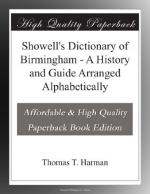Birmingham in 1731.—An old “Road-book” of this date, says that “Birmingham, Bromicham, or Bremicham, is a large town, well built and populous. The inhabitants, being mostly smiths, are very ingenious in their way, and vend vast quantities of all sorts of iron wares.” The first map of the town (Westley’s) was published in this year. It showed the Manorhouse on an oval island, about 126 yards long by 70 yards extreme width, surrounded by a moat about twelve yards broad. Paradise Street was then but a road through the fields; Easy Hill (now Easy Row), Summer Hill, Newhall Hill, Ludgate Hill, Constitution Hill, and Snow Hill pleasant pastures.
Birmingham in 1750.—Bradford’s plan of the town, published in 1751, showed a walk by Rea side, where lovers could take a pleasant stroll from Heath Mill Lane. The country residences at Mount Pleasant (now Ann Street) were surrounded with gardens, and it was a common practice to dry clothes on the hedges in Snow Hill. In “England’s Gazetteer,” published about this date, Birmingham or Bromichan is said to be “a large, well-built, and populous town, noted for the most ingenious artificers in boxes, buckles, buttons, and other iron and steel wares; wherein such multitudes of people are employed that they are sent all over Europe; and here is a continual noise of hammers, anvils, and files.”
Birmingham in 1765.—Lord and Lady Shelburne visited here in 1765. Her ladyship kept a diary, and in it she describes Mr. Baskerville’s house (Easy Row) as “a pretty place out of the town.” She also mentions visiting a Quaker’s to see “the making of guns.”
Birmingham in 1766.—In “A New Tour through England,” by George Beaumont, Esq., and Capt. Henry Disney, Birmingham is described as “a very large populous town, the upper part of which stands dry on the side of a hill, but the lower is watry, and inhabited by the meaner sort of people. They are employed here in the Iron Works, in which they are such ingenious artificers, that their performances in the smallwares of iron and steel are admired both at home and abroad. ’Tis much improved of late years, both in public and private buildings.”
Birmingham in 1781.—Hutton published his “History of Birmingham” this year. He estimated that there were then living ninety-four townsmen who were each worth over L5,000; eighty worth over L10,000; seventeen worth over L20,000; eight worth over L30,000; seven worth over L50,000; and three at least worth over L100,000 each.
Birmingham in 1812.—The appearance of the town then would be strange indeed to those who know but the Birmingham of to-day. Many half-timbered houses remained in the Bull Ring and cows grazed near where the Town Hall now stands, there being a farmhouse at the back of the site of Christ Church, then being built. Recruiting parties paraded the streets with fife and drum almost daily, and when the London mail came in with news of some victory in Spain it was no uncommon thing for the workmen to take the horses out and drag the coach up the Bull Ring amid the cheers of the crowd. At night the streets were patrolled by watchmen, with rattles and lanterns, who called the hours and the weather.




